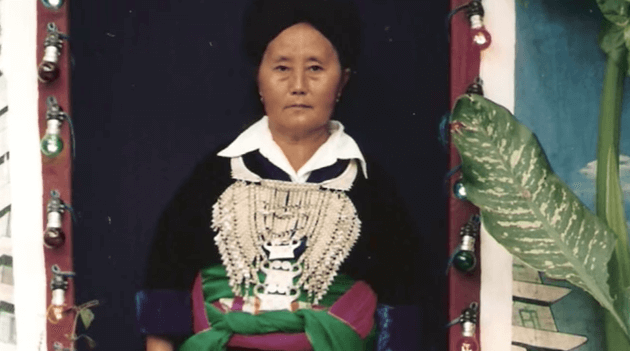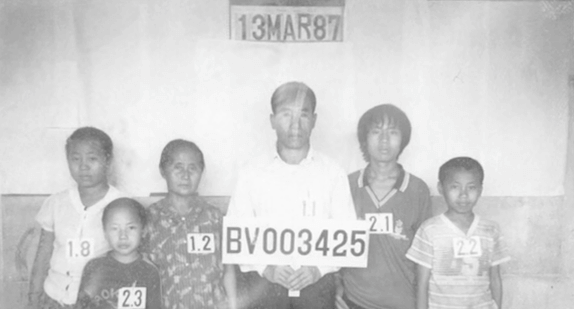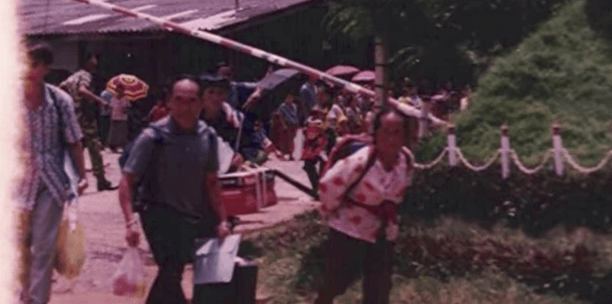
 A Minnesota PBS Initiative
A Minnesota PBS Initiative
I am Song Vue. I am going to tell my story to my child. We lived in Laos and only ever heard our parents tell us about escaping from China. We never actually knew or experienced it. We were young and can’t remember, either, but now we have experienced it firsthand. We escaped with our children, just like the elders told us about China.
We ran to the jungles and were starving. All we ate were vegetation and roots. Wherever we went, there was no shelter. We hid and took shelter where we could. If we reached a cave, we would hide in the cave. It was a terrible thing, having to escape the same way our elders did.
We didn’t understand before and then we received the same fate. It’s very sad.
We ran until we were hungry.

They said our country would be no more and we would suffer. People had already abandoned (Laos) and left to Thailand. Finally, my family escaped with our relatives. At that time, we escaped with 50-100 people. I can’t remember.
During our journey, it was difficult for my children. They cried a lot. I had nine children. The older children were able to carry things and the two oldest could fend for themselves but my two younger sons had a difficult time. For a whole day and nights, they cried. They cried a lot but I couldn’t do anything because I carried my youngest on my back.
Everyone was carrying something and my husband carried the rice sack. My two sons were struggling and crying so sometimes they were carried or their hands were held. We left Laos in May. It was planting season. All the corn and wheat was planted. The moment we crossed the river the moon shone brightly that night in May when we got to Thailand. We got to Thailand in 1979, May of 1979. We must live righteously. We were fortunate to not meet tragedy on our journey. We all arrived healthy and well. Heaven and Earth saw us through. They recognized the good in us and ensured our safety and health.


When we got to Thailand, many others arrived as well. But then you think, “Well, we’ve arrived but will we stay or go to America?” We ended up staying for 10 years. People arrived and left. We didn’t have a country anymore so it was time to go to a better, more prosperous place. So, we steeled our hearts and came. We left Thailand on September 7th but wound up in Phanat Nikhon for one year before coming to the U.S.. We departed Thailand from there to come to the United States.
We came to the U.S. for a better life. That’s how we prepared our hearts for the journey to this country. When we arrived, we were too old to learn in school. There wasn’t much for us to do so we just ate what we were given. Our children were young and able to learn new things but we were old and no longer able to make a living. We live our lives simply. If we are fed, we eat. If they don’t feed us, it’s okay. If we are scolded, we endure it. We endure and ask for forgiveness.
We came for the opportunity to live longer, to be able to see the world, to be able to see our children and grandchildren grow up. This is my story.
Song Vue Translation
Ntawm no kuv yog Ntxhoo Vwj os. Kuv zaj dab neeg no kuv yuav hais rau me nyuam. Peb nyob ntuj qub qab ces, thaum hnov tej niam tej txiv hais tsov rog tom suav teb xwb. Yus tsis tau paub thiab yus tsis tau pom li nawb. Yus tseem yau, yus twb khaws tsis tau thiab, es tam sim no yus thiab pom ntawm yus lub qhov muag, yus thiab li pus tej me nyuam khiav rau hav zoov hav tsuag li tej laus tham tom suab teb. Khiav khiav rau me hav zoov hav tsuag, tshais tshais, noj me nplooj hmab nplooj ntoo xwb. Noj me kau xyoob kau ntoo xwb. Khiav mus txog twg ces, tsis muaj vaj muaj tsev ces duab zoo duab tsuag ces khiav txog twg, khooj twg xwb nawb. Khiav mus txog mi qab zeb, los khooj qab zeb. Khiav txog qab ca los khooj qab ca. Txom nyem khawg, txoj kev khiav tsov rog mas, thaud tej laus tham, Yus tsis paub, tam sim no yus raug txoj kev khiav li thaud tej laus, yeej txom nyem khaws nkaus nawb. Khiav khiav ces tshais, ces lawv hais tias, “Oh, ntshe lub teb chaws yuav tsis muaj, yuav txom nyem”. Ces, khiav, luag tej luag chaws luag twb poom tag, luag khiav luag mus rau thaib teb lawm ces, Peb cov niam txiv tub thiaj nrog cov kwvtij sawv daws khiav los. Thaum ntawd, los ib puas leej los xyov yog tsib caug rauscaum leej naws. Tsis nco qab lawm. Ces, peb los ces, Oh, tej me nyuam los tsis tau, tej me nyuam quaj khaws nkaus. Kuv ces, kuv cuaj tug, kuv cuaj tug me nyuam nawb. Cov loj ces nrij tau nras thiab tus hlob ces nhriav tau noj, pab tau yus lawm. Tiam sis muaj ob tug me tub yaus, los tsis tau li. Los tau ib hnub thiab ib hmo ces, quaj khaws nkaus. Quaj khaws nkaus los, nyias dais nyias ib pob tau noj thiab kuv dais tus yaus thiab tus txiv hos ris mov thiab ces ob tug me tub ntawd mas los tsis tau lawm ces quaj quaj ces tej tsam lawm hos nqa, tej tsam lawm hos tuaj teb. Tim teb chaws nplog los, peb los lub tsib hli ntub nawm. Es, lawv, tej me poj kwb dauv tws qaib tag, cov neeg twb cog nplej ntxov twb cog tag lawm thiab. Peb los hla dhau plaws dej ces yog lub tsib hli ntuj nra nra pom pom kev nawb. Peb thiaj los poob rau thaib teb. Peb los txog thaib teb yog xyacaum cuaj, peb los poob thaib teb xyacaum cuaj, lub tsib hli ntuj ntawm. Ces, ua neej nyob, ua tub ncaj nawb. Peb cov niam txiv tub peb los lo peb tsis raug kev txom nyem dabtsi li. Peb tuaj txog, saws daws nyob dhia rhwb rhees, Huam tais ntuj thiab huam tais vaj tswv, lawv yeej paub hais tias, peb los peb cov niam txiv tub yog neeg dawb neeg huv, yog neeg zoo, neeg siab zoo, neeg siab dawb tsis ua phem rau leej twg, tsis cev leej twg, tsis nrog leej twg ua plaus ua ntug, peb thiaj nyob kaj nyob hus. Peb tuaj txog Thaib teb ces, luag tuaj luag lawm zom zaws thiab, tias si yus xav hais tias, “Oh, tuaj txog haum es yuam nyob haum los tuaj rau teb chaws no?” ces, nyob nyob ces, kaum lub xyoo ces luag tuaj lawm zom zaws ces, thiab hais tias, aub, tsis muaj teb muaj chaws lawm ces luag mus tag ces yuav mus lau, mus rau lub teb chaws vam meej xwv thiaj ho tau zoo no ces thiab npaj siab tuaj lawm. Es, peb sawv kev haum thaib teb tuaj lub cuaj hli ntuj vas thib xya. Ces peb tuaj poob rau tom Phanab Nikhon ,ces peb tuaj nyob rau ib xyoo tom. Peb tawm tom tuaj rau teb chaws meskas no ces. Tuaj tebchaws meskas no ces, xav hais tias tuaj kom tsis txom nyem es thiab muaj tus hlub, tus cawm yus es thiab tsis raug kev txom nyem. Thiaj npaj siab tuaj rau lub teb chaws no. Tuaj txog ces laus laus, kawm tsis tau ntawm lawm lo. Tuaj nyob dawb xwb, thov noj thov haus xws, luag pub li cas los noj li ntawm os. Tej me nyuam ces tseem hluas, lawm tuaj kawm txuj kawm ci lawm ho yus laus laus ces tuaj txog ces yus mob mob laug yus ua tsis tau noj lawm. Ua neej nyob, peb cov niam txiv tub, peb ruam ruam. Luag pub los peb noj, luag tsis pub los tsis ua cas. Luag cem peb los peb nyoo, nyoo zam txim pub luag. Npaj siab kom muaj txoj sia nrog luag nyob es muaj txoj sia ntev es thiab pom lub teb lub chaws es thiaj pom mi tub me nyuam, pom xeev leej xeeb ntxwv no os mog. Kuv hais zaj dab neeg no ces kuv hais li no xwb nawb.
Story Themes: Escape, Hmong, Immigrant Stories, Laos, Refugee, Secret War, Video, Women